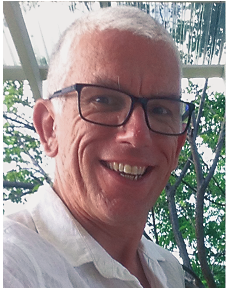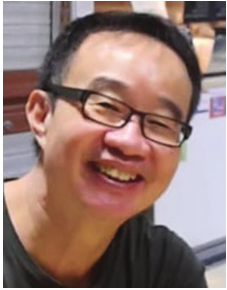PDFLINK |
Caroline Series and Hyperbolic Geometry
Communicated by Notices Associate Editor Chikako Mese
Caroline Series.

1. Introduction
Caroline Series has made important contributions to hyperbolic geometry and symbolic dynamics, and her elegant and clear explanations of the connections between these two topics together with carefully chosen examples that explore the beautiful geometry underlying many spaces of Kleinian groups have influenced a generation of hyperbolic geometers and dynamicists.
Caroline obtained her BA at the University of Oxford in 1972 and her doctorate at Harvard University in 1976 under the supervision of George Mackey. She spent the first couple of years of her career at Berkeley and Cambridge before settling in Warwick in , where she stayed until her retirement in . Her stint at Berkeley led to an important but short-lived collaboration with Rufus Bowen which ended abruptly when Bowen passed away unexpectedly in July 1978. Her work on the connections between symbolic dynamics and hyperbolic geometry done during the early period of her career led to an invitation to speak at the ICM at Berkeley in . She has received numerous awards and honors for her work including the Senior Anne Bennett Prize (LMS, 2014), Junior Whitehead Prize (LMS, 1987), Fellow of the Royal Society (2016), and the David Crighton Medal (IMA-LMS, 2021). She has honorary degrees from Duke and St Andrews Universities and is a Fellow of the AMS. She served as president of the LMS (London Mathematical Society) from 2017 to 2019.
The 1990s and 2000s saw intense activity in the fields of hyperbolic geometry, hyperbolic -manifolds, and Kleinian groups following the revolutionary ideas and conjectures of William Thurston. Many important conjectures like Thurston’s geometrization conjecture, Marden’s tameness conjecture, the virtual Haken conjecture, the ending lamination conjecture, and the Ahlfors measure conjecture were solved during this period. During her tenure at Warwick, working alongside David Epstein, Caroline played a pivotal role in helping to make the Mathematics Institute there a leading international center for hyperbolic geometry, organizing many large conferences and programs attended by leading researchers in the field. She also played host and mentor to a large number of young international visitors, particularly researchers from Japan. We give below a description of some of her considerable contributions to the field.
2. Symbolic Dynamics and Fuchsian Groups
Caroline wrote her thesis on Mackey’s theory of virtual groups, which involves the ergodic theory of groups acting measurably on measure spaces; in particular two groups acting on measure spaces and preserving measure classes are said to be orbit equivalent if there is a measure class preserving map from to which sends the orbits of to the orbits of . Note that are not necessarily isomorphic, nor does necessarily preserve any order in individual orbits. By a remarkable result of H. Dye, all finite measure preserving actions of are orbit equivalent; such actions are called hyperfinite. Caroline’s first contributions involved various results in this area; see for example Ser78.
Starting in the late 1970s, Caroline wrote a number of important papers elucidating the connections between hyperbolic geometry and symbolic dynamics. We start with a simple but very illuminating result concerning continued fractions and cutting sequences of geodesics.
The cutting sequence of and across the Farey tessellation.

2.1. Continued fractions and cutting sequences
Recall that the upper half plane
and the unit disk
both serve as models for the hyperbolic plane with ideal boundary and respectively. In an elegant paper Ser85b, Caroline explained the beautiful relationship between the continued fraction of and the manner in which the hyperbolic geodesic joining some point on the positive imaginary axis to cuts across the Farey triangulation of . That there seemed to be a close connection between continued fractions and cutting sequences of geodesics across the classical fundamental domain of the modular group had been known for some time, but details remained elusive. Caroline was the first to give a precise relation using the left/right cutting sequences explained next.
The Farey triangulation of is a tessellation by triangles each of whose vertices lie in . Its edges are the hyperbolic geodesics joining Farey neighbors, where two fractions in reduced form are called Farey neighbors if , with the convention that . (Recall that a geodesic in is a semicircle with center on or a vertical line.) The tessellation can be built up recursively using “Farey addition” as follows; for simplicity we restrict to the right half plane. Start from an initial triangle with vertices at , and and note that each pair of vertices are neighbors. Two Farey neighbors and spawn a new vertex which is a neighbor of both. Thus, for example, neighbors spawn , while spawn . Joining each pair with a hyperbolic geodesic defines new triangles with vertices and . Repeating this procedure generates .
Now let and consider the oriented geodesic from a point on the positive imaginary axis to . Its left/right cutting sequence across is defined as follows: if cuts a triangle of with single vertex on the left it is recorded as a left cut , while if the single vertex is on the right, it is a right cut ; see Figure 2. The cutting sequence for is then , with the convention that the initial term is omitted if .
Now suppose is expressed by the continued fraction
where , for . Then
(Series Ser85b 1985) For , its continued fraction is if and only if the geodesic ending at has left/right cutting sequence .
Notice that if then ends at a vertex of the tessellation so that the label of the final cut is ambiguous, corresponding exactly to the ambiguity in the final terms or of finite continued fractions. Left/right cutting sequences are now widely used.
2.2. Special tessellations and symbolic dynamics
This theme of using special tessellations of or arising from Fuchsian groups with special fundamental domains, and the associated cutting sequences, to describe the dynamical behavior of the geodesic flow occurs in several of Caroline’s other works. In particular, it features in an earlier well-known paper BS79 with Bowen which explained the connection between Fuchsian groups and symbolic dynamics. Here it is convenient to use the model with ideal boundary and isometry group .
Recall that if is a finitely generated Fuchsian group, then is discrete and is a hyperbolic surface, possibly with cusps, boundary components, and cone points.
A piecewise differentiable map is called Markov if there is a finite partition of into intervals such that is a union of intervals . This means that the associated symbolic dynamics is of finite type; that is, an infinite sequence , , , … of labels records the intervals through which an orbit of passes if and only if each pair of adjacent symbols in the sequence is permissible. Furthermore, the map is orbit equivalent to the action of the Fuchsian group on if, except for a finite number of pairs of points, , with if and only if there exists such that .
(Bowen, Series BS79) For any finitely generated Fuchsian group , there exists a Markov map of which is orbit equivalent to the action of on its limit set . This map admits a unique finite invariant measure, which, in the case of a group for which , is equivalent to the Lebesgue measure.
For any surface of fixed topological type, the proof involves the clever idea of first considering a particular Fuchsian group whose quotient surface is homeomorphic to , together with a special type of fundamental domain with corresponding tessellation of (described below). This is used to construct the partition of and the Markov map of the theorem. Then using the theory of quasiconformal deformations, the result can be extended to a general Fuchsian group whose quotient is homeomorphic to .
A fundamental domain in is special if it is a finite-sided convex polygon whose sides, when extended, are contained in the tessellation of arising from the translates of in . The sides should be matched in pairs by isometries which form a generating set for . From this one constructs a partition of with the requisite Markov property, and such that moreover each interval in the Markov partition is associated to a specific generator of . Footnote1
In BS79 it was required that the sides of the fundamental domain were part of the isometric circles of the corresponding side pairings of , but in fact this condition is not necessary.
Continuing along the same lines, in Ser81, Caroline explicitly constructs a symbolic dynamics for the geodesic flow on any hyperbolic surface by associating to each geodesic a doubly infinite sequence in the two-sided extension of the above Markov shift. Roughly speaking, this is done by mapping the two endpoints of a lifted geodesic to the semi-infinite sequences associated to it by the Bowen–Series map constructed above. By making precise the connection between this coding and the cutting sequence obtained by reading off the labels of sides of traversed by in its passage across , she elucidated the connection between the Artin and Koebe–Morse methods for obtaining symbolic representations of geodesic flows on surfaces of constant negative curvature; see also Ser86. This circle of ideas is now a standard starting point for many results on orbit counting and symbolic dynamics. Later, she made many applications of this coding to Fuchsian groups, for example to the word problem BS87, to random walks Ser83, to group cohomology BS84, and to simple curves on surfaces, of which more below.
Caroline with colleagues David Fowler (left) and David (Dai) Evans in the maths common room at Warwick, 1980.
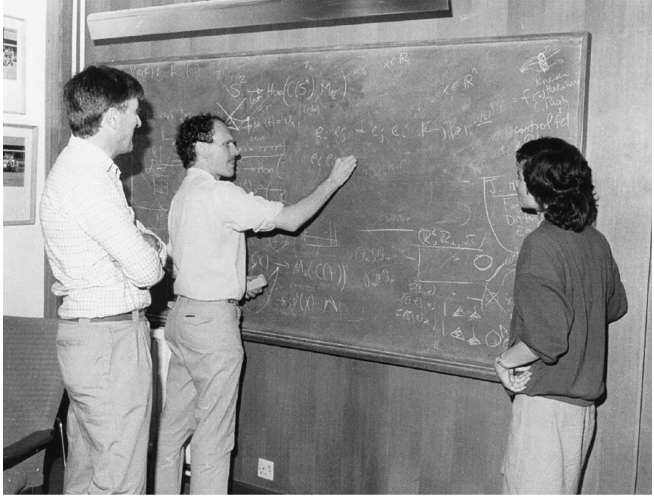
3. Curves on Surfaces
In the s, together with Joan Birman, Caroline wrote a series of papers studying curves on hyperbolic surfaces, in particular their self-intersection numbers. These used many of the ideas she had used in her earlier work on cutting sequences of geodesics and the associated symbolic coding. The most influential of these was a paper containing a remarkable theorem about the sparsity of the set of points lying on complete geodesics with bounded self-intersection on a hyperbolic surface of finite type, that is, of finite genus with finitely many cusps or boundary components.
3.1. Geodesics with bounded self-intersections
Let be a closed hyperbolic surface of finite type and let be the set of all complete geodesics on which have at most self-intersections. In particular, is the set of complete simple geodesics on .
(Birman, Series, BS85 1985) Let . The set of points on lying on any geodesic is a set of Hausdorff dimension and is nowhere dense.
This result contrasts with the case of a Euclidean torus where every point on is contained in some simple geodesic. It also contrasts with the case of a generic geodesic on which is typically dense on . The set is now commonly referred to as the Birman–Series set.
The main idea behind the proof is very simple and elegant. We give a brief sketch for the case of simple geodesics on a closed hyperbolic surface .
The first or so simple curves ordered by length on a genus two surface . Graphics by Peter Buser and Hugo Parlier from their paper “Quantifying the sparseness of simple geodesics on hyperbolic surfaces.”
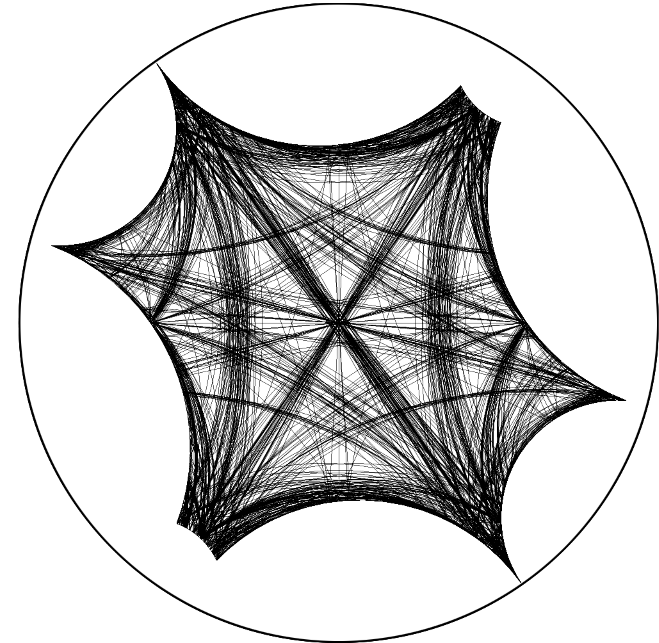
Choose a finite-sided convex polygonal fundamental domain for with sides labelled on the inside. The images of under define a tessellation of and the action carries the labelling to each copy of in . Suppose is a simple geodesic (closed or otherwise) on . Since glues up to reconstitute , the lifts of to appear as a collection of disjoint strands across . Starting with the strand and working backward and forward, we can trace the sequence of sides in which cuts , numbered so that is the strand between labels and . This is called the cutting sequence of .
Now suppose that and are two such geodesics whose cutting sequences and are such that for . Lifting and to in such a way that are the strands between labels and , we see that the initial segments of the lifts and begin at points on the same side of the same copy of , so that are a bounded distance apart, and likewise for the final points of the segments . It follows from the properties of hyperbolic geodesics that the segments between the cuts labelled are exponentially close, that is, they lie in some strip connecting two sides of of width less than for some constant .
Requiring that a geodesic is simple is extremely restrictive because its segments across must all be disjoint. These segments can be isotoped so that each crossing of a side of is at the midpoint of the side, resulting in a graph whose vertices are the midpoints of sides of and whose edges are arcs between these vertices. Moreover all its edges are disjoint. Clearly there are only finitely many such graphs. Now given the number of arcs between the sides labelled and , one can reconstruct up to isotopy the segment of between the initial and final points . If and share the same th forward and backward cutting sequences, then for all and moreover . It follows that there are only possibilities for the cutting sequences, where is a polynomial of degree equal to the number of edges of . Hence the projections of the segments onto lie in a collection of strips of width bounded by for some , and the number of such strips is bounded by . Letting gives the result.
Notice that this also gives a polynomial upper bound for the number of simple curves of length bounded by ; this type of bound was vastly improved by Mirzakhani; see the next section.
The proof can be adapted easily to the case of geodesics with bounded intersection, and for surfaces with cusps and/or geodesic boundary. The Birman-Series set contains a wealth of information and has been intensively studied. An illustration of a subset of on a perturbation of the Bolza surface (the genus two surface with maximal symmetry group) is given in Figure 4.
3.2. Identities and other applications
The above result has many consequences, and also raises many questions about geodesics of bounded intersection on . It has led to an active field of research and some surprising applications. In his Warwick PhD thesis, Greg McShane studied the nature of the Birman–Series set for a hyperbolic once-punctured torus, and in particular its intersection with the horocycle of length one about the cusp. This is a nowhere dense subset of zero measure on the horocycle, and by studying the complementary gaps, he obtained the following remarkable identity:
Let be a complete hyperbolic once-punctured torus. Then
where the sum is over the set of simple closed geodesics on and denotes the length of .
This was subsequently generalized first by McShane himself to general surfaces with cusps McS98 and then by Maryam Mirzakhani Mir07 to surfaces with geodesic boundary, where, in a tour de force, she used her formulae to determine the volumes of the moduli spaces of surfaces with geodesic boundary. There is now a large body of work on various other generalizations and applications by Bowditch, Akiyoshi–Miyachi–Sakuma, Tan–Wong–Zhang, Labourie–McShane, and several others which trace their inspiration to the original Birman–Series result.
In another direction, as noted above, the Birman–Series result raises the question of the growth rate of geodesics in with length less than as . This has also led to a large body of work, notably by Rivin, Mirzakhani (), Erlandsson–Souto (), Sapir, and Erlandsson–Parlier–Souto.
4. Pleating Rays
In the 1990s, Caroline shifted her attention to Kleinian groupsFootnote2 and hyperbolic three manifolds. Together with Linda Keen, she invented the theory of pleating rays. These rays (or their higher-dimensional analogues pleating varieties) foliate spaces of various parametrized families of Kleinian groups. Initially inspired by the computer graphics of Mumford and Wright which showed that the limit sets of many two generator groups consist of chains of overlapping or tangent circles such as are clearly visible in Figure 6, the theory was initially worked out with Keen in the case of two special one complex dimensional families, the Maskit and Riley slices of Schottky space, described in more detail below.
A Kleinian group is a discrete group of orientation-preserving isometries of hyperbolic -space , identified with .
4.1. Background
As Keen and Series discovered, the key to understanding these Mumford–Wright graphics is to pass to the hyperbolic convex hull of the limit set of a Kleinian group in hyperbolic -space. Thurston described the boundary as a pleated surface: this is a surface made up of pieces of hyperbolic planes, meeting along hyperbolic lines called bending lines; see Figure 5. This surface itself carries an intrinsic hyperbolic structure so that is a collection of hyperbolic surfaces. Also recall that acts discontinuously on , the complement of the limit set in and that the quotient is a collection of Riemann surfaces. It can be shown that the surfaces are homeomorphic to the Riemann surfaces , although with different hyperbolic structures.
Using this circle of ideas, Keen and Series were able to relate circle patterns in to the shape of . In the upper half space model of hyperbolic space , a plane is a vertical half plane or a hemisphere with center on the boundary , identified in this model with . Likewise a hyperbolic geodesic or line is a vertical line or semicircle with center on . Thus a circle or arc of a circle in gives rise to a plane or part plane in , likewise two circles which overlap give rise to intersecting planes which meet along a bending line in . The bending lines project to disjoint geodesics on and thus are either simple closed curves or, in the case of non-closed curves, what Thurston called a (measured) geodesic lamination. Such laminations can be organized as a space of projective measured laminations, denoted ; for present purposes it suffices to note that contains simple closed curves or multi-curves as a dense subset. Such laminations are called rational for reasons which will be clearer in the next section.
The boundary of the hyperbolic convex hull of a Kleinian group limit set is a pleated surface made up of pieces of hyperbolic planes meeting along hyperbolic geodesics called bending lines.
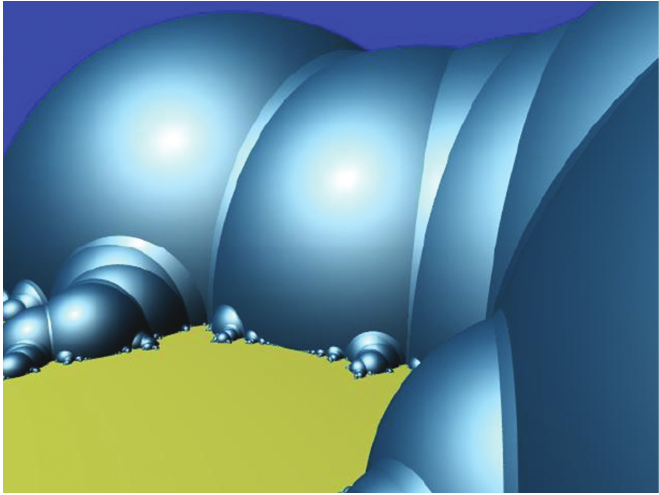
A pleating ray as introduced by Keen and Series is by definition the locus in some parameter space of Kleinian groups on which the bending lamination is a fixed element in . It is called rational if the corresponding lamination is rational, that is, comes from bending lines which project to simple closed curve or multi-curves on . In the case of “rational rays” the limit set of the group is formed by chains of overlapping circles such as are apparent, for example, in Figure 6. Movement along the ray corresponds to keeping the same combinatorial pattern while varying the radii and angles of overlap between the circles. A key point for both theory and computations is that on a rational ray, the traces of the corresponding group element or elements are real valued.
Using some of the powerful ideas of Thurston theory, Keen and Series were able to show the rational rays have many remarkable properties. In spaces involving one complex parameter such as the Maskit and Riley slices described below, they were able to compute the rational rays explicitly showing that they fill out the entire space of discrete free groups in the given family densely. This gave in particular an algorithmic way in which to locate the boundary between discrete and non-discrete groups.
This should all become clearer when we look at two particular examples explained in the following two sections.
4.2. The Maskit slice
Limit set of a group on the ray in the Maskit slice, . The disks bounded by full circles in all project to the triply punctured sphere boundary while the overlapping circles give rise to part hyperbolic planes. The lines along which they intersect project to the curve on .
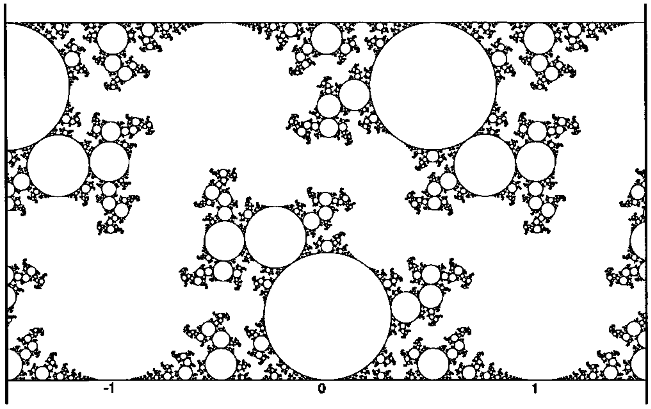
The Maskit slice. The pleating rays are the approximately vertical lines. The approximately horizontal lines represent laminations with the same length, appropriately normalized.
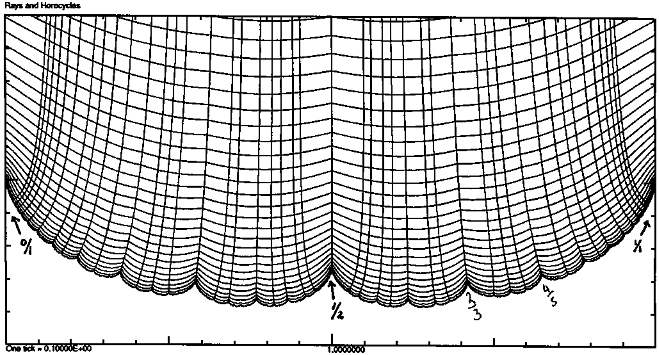
Let
The Maskit slice is the set
This set has two components which are symmetric under reflection across the real axis, both of which by results of Bers can be identified with the Teichmüller space of the punctured torus . We consider the upper component ; see Figure 7.
For , let be the complement in of the limit set of . As the reader can discern from Figure 6 with a bit of effort, consists of a simply connected component which is invariant under the action, together with a collection of round disks each of which is fixed by a subgroup of and which together form a single -orbit under the action. The component of is a once-punctured torus , while all the other disk components all project to a single triply punctured sphere. Since a hyperbolic triply punctured sphere is rigid, its geometry is fixed independent of .
Now the component faces a component of the convex hull boundary . As discussed in the previous section, is homeomorphic to hence is itself a hyperbolic once-punctured torus with the hyperbolic structure induced from the ambient space . Thus the possible bending lines on the pleated surface are the possible geodesic laminations on . With respect to a particular generating set, a simple closed curve on winds around times in one direction and in the other, so can be indexed by a rational number . Thus the set of simple closed curves is identified with the rational numbers . Thurston’s theory shows that the space of projective measured laminations on can be identified with the closure , that is, the extended real line
Following the discussion in the previous section, the
In KS93, Keen and Series explicitly describe the rational pleating rays for
The rational pleating rays are clearly pairwise disjoint. They show further that they are dense in
4.3. The Riley slice
Let
The Riley slice is the set
This slice was studied by Keen and Series in KS94. For
By realizing
A similar analysis for a family of groups corresponding to a hyperbolic
The Riley slice with extended pleating rays.

The family of groups
Following a suggestion of Sakuma, and as explained by Caroline in her 2019 Presidential Lecture, it is conjectured that the pleating rays may be analytically continued along arcs where
As a consequence of unpublished results of Ian Agol, recently completed by Sakuma and several collaborators including the first author, the Heckoid groups and knot or link complement groups are the only discrete
4.4. Pleating varieties
Subsequent to these results on the Maskit slice and the Riley slice, Caroline went on to generalize pleating rays to families of Kleinian groups depending on more parameters, thus relating to higher genus surfaces.
In one direction, Caroline considered Maskit embeddings for higher complexity surfaces. She proved general results on the top terms of the trace polynomials, first for the case of twice-punctured torus, jointly with Keen and the first author KPS99, and then for all surfaces, in joint work with her student Sara Maloni MS10. Caroline then gave formulae for the asymptotic directions of pleating varieties in the case of the twice-punctured torus, the general case being worked out by Maloni in her thesis.
In another direction, one can consider pleating varieties for families of quasifuchsian groups
In this case one has to consider two geodesic laminations,
Keen and Series made an initial analysis of this situation in the case of once-punctured tori and showed that all possible pairs of distinct projective laminations can occur. In PS95, she and the first author looked in detail at the case in which the bending laminations are a pair of closed curves which intersect exactly once, deriving exact formulae for the relationship between the bending angle between planes in
The case of twice-punctured tori was studied in various papers with Raquel Díaz, Linda Keen, and the first author. Caroline then showed in Ser05 that for any surface, the pleating variety associated to the pair of laminations
In an important paper with Young Choi CS06, she went on to extend the one-dimensional result on non-singularity of pleating varieties by proving that for general Kleinian groups the complex lengths of the bending lines are local holomorphic parameters for the ambient parameter space.
Caroline has a number of other more general results on hyperbolic
Caroline with Yair Minsky and Makoto Sakuma at her Spaces of Kleinian Groups programme at the Isaac Newton Institute, 2003.

5. Exposition and Service to Community
An important contribution of Caroline’s to the field has been her expository work which has brought the fascination of the subject to many young mathematicians and the broader public. Her paper Ser85a on the geometry of the Markoff numbers was a very attractive and elegant exposition of the intimate connections between number theory, Diophantine approximation, hyperbolic geometry, and the modular hyperbolic punctured torus which has been read by generations of students.
One cannot discuss Caroline’s work without mention of her aptly named and lavishly illustrated book Indra’s Pearls written jointly with David Mumford and David Wright. This widely praised book describes everything that is needed to understand and draw limit sets of two-generator Kleinian groups, including basic computer algorithms needed to make the pictures. Written so that very little technical knowledge is required and beautifully illustrated with quirky figures, precise geometric drawings, and intricate computer-generated figures, its appeal extends not just to experts in the field, but also to undergraduates and amateur mathematicians. In particular it explains and illustrates the many extraordinarily striking and intricate patterns that arise in these limit sets, such as those shown in Figures 6 and 10, and it touches on some of the combinatorial ideas describing the possible cutting sequences for simple geodesics used in her subsequent work with Linda Keen.
Another important contribution of Caroline is her substantial service to the mathematical community at large. She has an immensely influential track record in opening up the subject to underrepresented groups, particularly for women. She was a founding member of European Women in Mathematics (EWM) in 1986 and has held senior roles in the EMS Women in Math Committee and the IMU Committee for Women in Mathematics. Together with other senior women, such as her long-term collaborators Joan Birman and Linda Keen, the effect that Caroline has had on improving gender equality in mathematics has been of great benefit to us all.
On the broader front, Caroline has made many significant contributions to organizations that support the mathematical community. She has given many years of dedicated service to the London Mathematical Society, the European Math Society, and the IMU. Within the LMS she has held several important roles, most notably, as already mentioned, serving as its president from 2017 to 2019. She twice served on mathematics panels for the UK Research Excellence Framework (REF). She has also been significantly involved in the Isaac Newton Institute, in recognition of which she was recently (2022) made an Honorary Fellow of the Institute.
Computer rendering by David Wright of the limit set of a two generator Kleinian group based on an original hand drawing by Fricke and Klein; see Fig. 156 in Vorlesungen über die Theorie der automorphen Functionen, Vol. 1, Leipzig 1897.
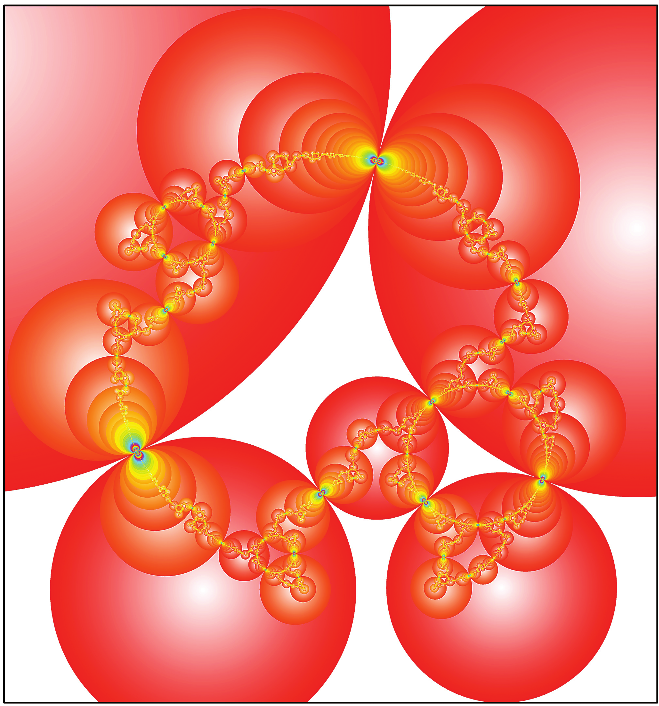
6. Conclusion
Caroline has made valuable and fundamental contributions to hyperbolic geometry, in particular, the geometry of hyperbolic surfaces and three manifolds. She has introduced important ideas, elucidating and clarifying connections between different aspects of hyperbolic geometry and symbolic dynamics. However, her contributions to the field go far beyond the mathematical aspects. She has been an influential role model who has fostered and nurtured a generation of young mathematicians who have gone on to make significant contributions in their own right. She has been particularly supportive of women mathematicians and other mathematicians from disadvantaged groups, both from official and unofficial positions. She has given numerous public talks which have contributed to the general public’s understanding of the work of research mathematicians. She has also organized and co-organized several major conferences, workshops, and meetings in her field, bringing together leading experts and generating a very vibrant and collegial atmosphere for research. She personally ensured that all participants, whatever their background, feel welcomed and part of the proceedings. In particular, she has been instrumental in fostering connections between European, American, and Asian researchers, strengthening in particular the Europe/Asia mathematical ties. Her efforts have helped create an inclusive and supportive atmosphere in the field, making it a very congenial and pleasant area to work in.
References
- [BS79]
- Rufus Bowen and Caroline Series, Markov maps associated with Fuchsian groups, Inst. Hautes Études Sci. Publ. Math. 50 (1979), 153–170. MR556585Show rawAMSref
\bib{MR556585}{article}{ author={Bowen, Rufus}, author={Series, Caroline}, title={Markov maps associated with Fuchsian groups}, journal={Inst. Hautes \'{E}tudes Sci. Publ. Math.}, number={50}, date={1979}, pages={153--170}, issn={0073-8301}, review={\MR {556585}}, }Close amsref.✖ - [BS84]
- Robert Brooks and Caroline Series, Bounded cohomology for surface groups, Topology 23 (1984), no. 1, 29–36. MR721449Show rawAMSref
\bib{MR721449}{article}{ author={Brooks, Robert}, author={Series, Caroline}, title={Bounded cohomology for surface groups}, date={1984}, issn={0040-9383}, journal={Topology}, volume={23}, number={1}, pages={29\ndash 36}, url={https://doi-org.libproxy1.nus.edu.sg/10.1016/0040-9383(84)90022-3}, review={\MR {721449}}, }Close amsref.✖ - [BS85]
- Joan S. Birman and Caroline Series, Geodesics with bounded intersection number on surfaces are sparsely distributed, Topology 24 (1985), no. 2, 217–225, DOI 10.1016/0040-9383(85)90056-4. MR793185Show rawAMSref
\bib{MR793185}{article}{ author={Birman, Joan S.}, author={Series, Caroline}, title={Geodesics with bounded intersection number on surfaces are sparsely distributed}, journal={Topology}, volume={24}, date={1985}, number={2}, pages={217--225}, issn={0040-9383}, review={\MR {793185}}, doi={10.1016/0040-9383(85)90056-4}, }Close amsref.✖ - [BS87]
- Joan S. Birman and Caroline Series, Dehn’s algorithm revisited, with applications to simple curves on surfaces, Combinatorial group theory and topology (Alta, Utah, 1984), Ann. of Math. Stud., vol. 111, Princeton Univ. Press, Princeton, NJ, 1987, pp. 451–478. MR895628Show rawAMSref
\bib{MR895628}{article}{ author={Birman, Joan S.}, author={Series, Caroline}, title={Dehn's algorithm revisited, with applications to simple curves on surfaces}, conference={ title={Combinatorial group theory and topology}, address={Alta, Utah}, date={1984}, }, book={ series={Ann. of Math. Stud.}, volume={111}, publisher={Princeton Univ. Press, Princeton, NJ}, }, date={1987}, pages={451--478}, review={\MR {895628}}, }Close amsref.✖ - [CS06]
- Young-Eun Choi and Caroline Series, Lengths are coordinates for convex structures, J. Differential Geom. 73 (2006), no. 1, 75–117. MR2217520Show rawAMSref
\bib{MR2217520}{article}{ author={Choi, Young-Eun}, author={Series, Caroline}, title={Lengths are coordinates for convex structures}, date={2006}, issn={0022-040X}, journal={J. Differential Geom.}, volume={73}, number={1}, pages={75\ndash 117}, url={http://projecteuclid.org.libproxy1.nus.edu.sg/euclid.jdg/1146680513}, review={\MR {2217520}}, }Close amsref.✖ - [KPS99]
- Linda Keen, John R. Parker, and Caroline Series, Combinatorics of simple closed curves on the twice punctured torus, Israel J. Math. 112 (1999), 29–60. MR1715014Show rawAMSref
\bib{MR1715014}{article}{ author={Keen, Linda}, author={Parker, John~R.}, author={Series, Caroline}, title={Combinatorics of simple closed curves on the twice punctured torus}, date={1999}, issn={0021-2172}, journal={Israel J. Math.}, volume={112}, pages={29\ndash 60}, url={https://doi-org.libproxy1.nus.edu.sg/10.1007/BF02773477}, review={\MR {1715014}}, }Close amsref.✖ - [KS93]
- Linda Keen and Caroline Series, Pleating coordinates for the Maskit embedding of the Teichmüller space of punctured tori, Topology 32 (1993), no. 4, 719–749, DOI 10.1016/0040-9383(93)90048-Z. MR1241870Show rawAMSref
\bib{MR1241870}{article}{ author={Keen, Linda}, author={Series, Caroline}, title={Pleating coordinates for the Maskit embedding of the Teichm\"{u}ller space of punctured tori}, journal={Topology}, volume={32}, date={1993}, number={4}, pages={719--749}, issn={0040-9383}, review={\MR {1241870}}, doi={10.1016/0040-9383(93)90048-Z}, }Close amsref.✖ - [KS94]
- Linda Keen and Caroline Series, The Riley slice of Schottky space, Proc. London Math. Soc. (3) 69 (1994), no. 1, 72–90. MR1272421Show rawAMSref
\bib{MR1272421}{article}{ author={Keen, Linda}, author={Series, Caroline}, title={The {R}iley slice of {S}chottky space}, date={1994}, issn={0024-6115}, journal={Proc. London Math. Soc. (3)}, volume={69}, number={1}, pages={72\ndash 90}, url={https://doi-org.libproxy1.nus.edu.sg/10.1112/plms/s3-69.1.72}, review={\MR {1272421}}, }Close amsref.✖ - [McS98]
- Greg McShane, Simple geodesics and a series constant over Teichmuller space, Invent. Math. 132 (1998), no. 3, 607–632, DOI 10.1007/s002220050235. MR1625712Show rawAMSref
\bib{MR1625712}{article}{ author={McShane, Greg}, title={Simple geodesics and a series constant over Teichmuller space}, journal={Invent. Math.}, volume={132}, date={1998}, number={3}, pages={607--632}, issn={0020-9910}, review={\MR {1625712}}, doi={10.1007/s002220050235}, }Close amsref.✖ - [Mir07]
- Maryam Mirzakhani, Simple geodesics and Weil-Petersson volumes of moduli spaces of bordered Riemann surfaces, Invent. Math. 167 (2007), no. 1, 179–222, DOI 10.1007/s00222-006-0013-2. MR2264808Show rawAMSref
\bib{MR2264808}{article}{ author={Mirzakhani, Maryam}, title={Simple geodesics and Weil-Petersson volumes of moduli spaces of bordered Riemann surfaces}, journal={Invent. Math.}, volume={167}, date={2007}, number={1}, pages={179--222}, issn={0020-9910}, review={\MR {2264808}}, doi={10.1007/s00222-006-0013-2}, }Close amsref.✖ - [MS10]
- Sara Maloni and Caroline Series, Top terms of polynomial traces in Kra’s plumbing construction, Algebr. Geom. Topol. 10 (2010), no. 3, 1565–1607. MR2661536Show rawAMSref
\bib{MR2661536}{article}{ author={Maloni, Sara}, author={Series, Caroline}, title={Top terms of polynomial traces in {K}ra's plumbing construction}, date={2010}, issn={1472-2747}, journal={Algebr. Geom. Topol.}, volume={10}, number={3}, pages={1565\ndash 1607}, url={https://doi-org.libproxy1.nus.edu.sg/10.2140/agt.2010.10.1565}, review={\MR {2661536}}, }Close amsref.✖ - [PS95]
- John R. Parker and Caroline Series, Bending formulae for convex hull boundaries, J. Anal. Math. 67 (1995), 165–198. MR1383492Show rawAMSref
\bib{MR1383492}{article}{ author={Parker, John~R.}, author={Series, Caroline}, title={Bending formulae for convex hull boundaries}, date={1995}, issn={0021-7670}, journal={J. Anal. Math.}, volume={67}, pages={165\ndash 198}, url={https://doi-org.libproxy1.nus.edu.sg/10.1007/BF02787788}, review={\MR {1383492}}, }Close amsref.✖ - [Ser05]
- Caroline Series, Limits of quasi-Fuchsian groups with small bending, Duke Math. J. 128 (2005), no. 2, 285–329. MR2140265Show rawAMSref
\bib{MR2140265}{article}{ author={Series, Caroline}, title={Limits of quasi-{F}uchsian groups with small bending}, date={2005}, issn={0012-7094}, journal={Duke Math. J.}, volume={128}, number={2}, pages={285\ndash 329}, url={https://doi-org.libproxy1.nus.edu.sg/10.1215/S0012-7094-04-12823-4}, review={\MR {2140265}}, }Close amsref.✖ - [Ser78]
- Caroline Series, The Rohlin tower theorem and hyperfiniteness for actions of continuous groups, Israel J. Math. 30 (1978), no. 1-2, 99–122, DOI 10.1007/BF02760832. MR508256Show rawAMSref
\bib{MR508256}{article}{ author={Series, Caroline}, title={The Rohlin tower theorem and hyperfiniteness for actions of continuous groups}, journal={Israel J. Math.}, volume={30}, date={1978}, number={1-2}, pages={99--122}, issn={0021-2172}, review={\MR {508256}}, doi={10.1007/BF02760832}, }Close amsref.✖ - [Ser81]
- Caroline Series, Symbolic dynamics for geodesic flows, Acta Math. 146 (1981), no. 1-2, 103–128. MR594628Show rawAMSref
\bib{MR594628}{article}{ author={Series, Caroline}, title={Symbolic dynamics for geodesic flows}, date={1981}, issn={0001-5962}, journal={Acta Math.}, volume={146}, number={1-2}, pages={103\ndash 128}, url={https://doi-org.libproxy1.nus.edu.sg/10.1007/BF02392459}, review={\MR {594628}}, }Close amsref.✖ - [Ser83]
- Caroline Series, Martin boundaries of random walks on Fuchsian groups, Israel J. Math. 44 (1983), no. 3, 221–242. MR693661Show rawAMSref
\bib{MR693661}{article}{ author={Series, Caroline}, title={Martin boundaries of random walks on {F}uchsian groups}, date={1983}, issn={0021-2172}, journal={Israel J. Math.}, volume={44}, number={3}, pages={221\ndash 242}, url={https://doi-org.libproxy1.nus.edu.sg/10.1007/BF02760973}, review={\MR {693661}}, }Close amsref.✖ - [Ser85a]
- Caroline Series, The geometry of Markoff numbers, Math. Intelligencer 7 (1985), no. 3, 20–29, DOI 10.1007/BF03025802. MR795536Show rawAMSref
\bib{MR795536}{article}{ author={Series, Caroline}, title={The geometry of Markoff numbers}, journal={Math. Intelligencer}, volume={7}, date={1985}, number={3}, pages={20--29}, issn={0343-6993}, review={\MR {795536}}, doi={10.1007/BF03025802}, }Close amsref.✖ - [Ser85b]
- Caroline Series, The modular surface and continued fractions, J. London Math. Soc. (2) 31 (1985), no. 1, 69–80. MR810563Show rawAMSref
\bib{MR810563}{article}{ author={Series, Caroline}, title={The modular surface and continued fractions}, date={1985}, issn={0024-6107}, journal={J. London Math. Soc. (2)}, volume={31}, number={1}, pages={69\ndash 80}, url={https://doi-org.libproxy1.nus.edu.sg/10.1112/jlms/s2-31.1.69}, review={\MR {810563}}, }Close amsref.✖ - [Ser86]
- Caroline Series, Geometrical Markov coding of geodesics on surfaces of constant negative curvature, Ergodic Theory Dynam. Systems 6 (1986), no. 4, 601–625, DOI 10.1017/S0143385700003722. MR873435Show rawAMSref
\bib{MR873435}{article}{ author={Series, Caroline}, title={Geometrical Markov coding of geodesics on surfaces of constant negative curvature}, journal={Ergodic Theory Dynam. Systems}, volume={6}, date={1986}, number={4}, pages={601--625}, issn={0143-3857}, review={\MR {873435}}, doi={10.1017/S0143385700003722}, }Close amsref.✖ - [STY17]
- Caroline Series, Ser Peow Tan, and Yasushi Yamashita, The diagonal slice of Schottky space, Algebr. Geom. Topol. 17 (2017), no. 4, 2239–2282, DOI 10.2140/agt.2017.17.2239. MR3685607Show rawAMSref
\bib{MR3685607}{article}{ author={Series, Caroline}, author={Tan, Ser Peow}, author={Yamashita, Yasushi}, title={The diagonal slice of Schottky space}, journal={Algebr. Geom. Topol.}, volume={17}, date={2017}, number={4}, pages={2239--2282}, issn={1472-2747}, review={\MR {3685607}}, doi={10.2140/agt.2017.17.2239}, }Close amsref.✖
Credits
Figures 1–3 are courtesy of Caroline Series.
Figure 4 is courtesy of Hugo Parlier.
Figure 5 is courtesy of Yair Minsky.
Figures 6, 7, and 10 are courtesy of David Wright.
Figure 8 is courtesy of Yasushi Yamashita.
Figure 9 is courtesy of Caroline Series.
Photo of John R. Parker is courtesy of John R. Parker.
Photo of Ser Peow Tan is courtesy of Ser Peow Tan.


